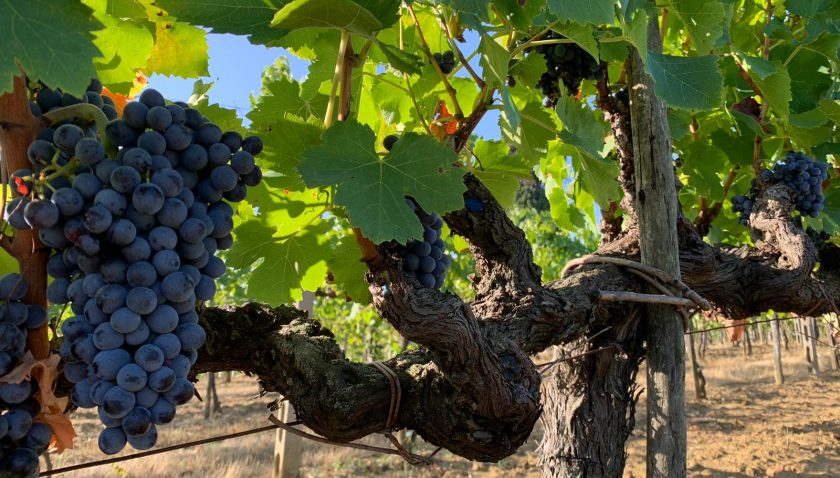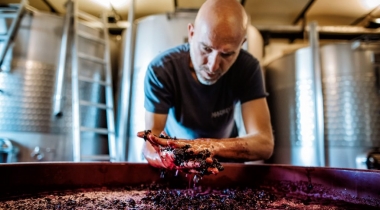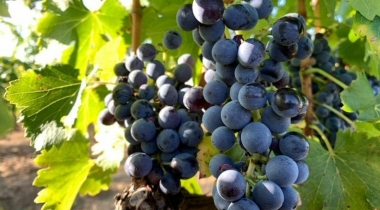The origin of my name is a case of mistaken identity, since I have nothing to do with the Gamay cultivated in the French region of Beaujolais (an AOC, or Appellation d’Origine Contrôlée area), near Lyon.
The error was probably made when the first viticultural transcriptions started to be made by those who traded with the South of France: the vignerons of that zone were asked the name of the grape that was cultivated in the same way on the shores of Trasimeno Lake.
Because of the mistake in identification that ensued, for a long time I was grown using the alberello (bush) training system, very different from the typical “vite maritata” technique (draped between trees) employed since the time of the Etruscans in the areas around Trasimeno Lake.
Recent genetic research carried out at the University of Perugia has demonstrated, on the other hand, that I belong to the family of the Grenaches, widespread in various zones of southern France. From these studies it emerged that Gamay del Trasimeno is the same variety known in other regions of Italy as Cannonau in Sardinia, Tai Rosso in Veneto, Bordò in Marche and, in other countries, as Garnacha (Spain), Grenache (France) and in general as Grenache Noir elsewhere in the world.
According to legend, my ancestors arrived on the shores of Trasimeno Lake around 1600, when Spain dominated Central and Southern Italy, followed by the peace treaty of Cateau-Cambrésis in 1559.
In fact, it is said that Duchess Eleonora Mendozza, who married Fulvio Alessandro della Corgna, the last lord of Castiglione del Lago, in 1610, brought as part of her dowry some vines directly from Spain as a token of good luck, but also because she was apparently a great enthusiast for the wine from this variety.
Between the end of the 19th and the early 20th century, Sardinian shepherds settled near Trasimeno Lake, arriving from the west, crossing the Maremma Toscana and the Orcia Valley. The migratory movement of two Sardinian transhumances towards the mainland consolidated the presence of my ancestors in this area.
Mystery hangs over my origins, and many scholars are still trying to find out what they are. The first documents referring to me were found around 1300 in Sardinia: here, in fact, texts were discovered that predated the Spanish ones of 1613, in which Cervantes mentions “Garnacha Blanca”.
In the end, a dramatic event seems to have given the coup de théâtre to those who thought that my native tongue was Catalan.
A group of archeologists, digging in Sardinia, discovered the presence of grape seeds dating from the time of the Nuragic civilization, which revealed themselves to belong to a grape variety akin to the Cannonau of today, my ancestor.
I can claim with certainty that I am indigenous to Trasimeno Lake. The place from which I arrived in the remote past (the 1600s) is of little importance: for centuries now, the lands that today correspond to the area of Umbria that is on the border with Tuscany (but which, at that time, constituted the independent marquisate of the Della Corgna family) have become for me an ideal location in which to establish myself. Here, I have acquired my own precise identity. It is quite clear that Trasimeno Lake has transformed me: it has given me a new dimension; it has provided me with balance and enriched me with new nuances.
I was used to having to stand up to very hot, dry weather, but here – where the climate is better ventilated and more humid – I express myself with greater elegance and freshness.
For this, I have to thank someone who believed in me and wanted, with everything in his power, to allow me to return to my former splendor: Nicola Chiucchiurlotto, of the company called Madrevite at Castiglione del Lago, who reproduced by clonal selection some very old Gamay vines that were present on his property (in the zone they called them “the French grapes”) and began some new plantings of them.
These are Nicola’s reminiscences:
Every time we had to spray the French vines with copper sulfate, the “Goldoni” tractor with a cord you had to pull to start it spluttered and then chugged proudly up the hill. Besides, it was the only vehicle that could enter into the little albarello vineyard
This is the finest memory I have of my adolescence in the midst of the fields and vine rows.
That of the French vines is a great story, to be enjoyed as you take in deep breaths in the vineyards. It goes back over half a millennium, to when the House of Aragon governed this part of Italy and introduced Garnacha, or should I say Grenache, for the first time.
Today we preserve the characteristics of that centuries-old vineyard thanks to the dedication and courage of grandfather Zino who, in the 1970s, grafted its ancient cuttings in a new plot of vines, as well as to the skilled efforts of my father, Eni, who has maintained it until the present day.Now that heritage that is so rich in biodiversity has been repropagated and the little vineyard where we used the “Goldoni” has been reconstituted. Today it gives us crisp, tasty grapes that then yield a fragrant and elegant wine.
My bunches are of medium size (200-300 grams in weight) and have a truncated conical shape; they are compact and have a wing. The grapes are fairly large and obovoid, with a bluish-violet skin covered in lots of bloom.
My distinctive characteristic is my erect shoots, which make it easier to train me using the alberello system, without the use of supports. My leaves are sub-circular and very shiny: this brightness reflects the sunlight and does not compromise the activity of the stomas. Their lower side is not covered in down. I am an isohydric variety, which means that I manage to regulate water loss and so manage to cope admirably in periods of drought.
I generally attain full ripeness in the last ten days of September..
I have generous yields, so I require operations that reduce the amount of fruit I produce, especially when I am young and my trunk is still smooth and not yet knotty.
I am a variety that does things slowly. The period of my budburst is tardy, or at least later than that of my colleague Sangiovese, which germinates towards the middle of April. I never produce an explosion of vegetation but rather steady growth, and I catch up on time both with my abundant flowering in early June and with a slow but constant véraison that begins around mid-August. I normally ripen towards the end of September, but actually this period can vary a lot, depending on a number of agronomic factors, always linked to the quantity of grapes that are left on my vines. I therefore recommend that the vine-grower does not get too greedy, otherwise my color and acidity will diminish.
I can be pruned in various way: certainly, my basal buds are fertile, and so to reduce yields I can be pruned short (Cordon or Palmette), but the grower must always pay attention to the fact that I have short internodes and so have a tendency to bundle up. If one is farming organically, these characteristics should not be overlooked. In this case a fruiting cane should be chosen to bend over, without forgetting that my bunches will always remain rather compact.
My character has been notably toned down since I have adapted to the sublime romanticism of the lake, which is responsible for having enriched me with a new sensibility. The nature of the lake contrasts with the harsh, well-defined countryside of the zones that are blinded by the sun and modelled by a bone-dry climate: its contours take on a dream-like softness, in a harmonious mixture of colors and fragrances.
When accompanied by other grapes I contribute color, character, body, and aging potential, but in this peaceful location I have found, on my own, an equilibrium that allows me to liberate all of my complexity with lightness and elegance, without being unduly excessive.
I prefer exposed, well-ventilated hillside sites, whose soil is moderately clayey, deep, and stony.
I have adapted to the zones around the perimeter of the lake, where one can find rock formations that are quite different from one another. I definitely have a preference for the zone to the west of the lake, where Madrevite’s vineyards are to be found. This area, which is particularly suited to red grape varieties, extends as far as Chiusi and, to the south, to Città della Pieve. It is the zone which, during the Upper Pliocene age, lay at the edge of that western sea that covered the whole of Tuscany, with periodic oscillation of the water level. This process led to the formation of marine sediments interspersed with coastal saline deposits and fluvial deposits. We are talking about more or less clayey sands, containing pebbles and differentiations due to the presence of marine, saline, or lacustrine fossils. This variability, together with the exposure of the slopes, guarantees an excellent area for my cultivation.
On the other hand, in the eastern part, below the lacustrine sediments, there are strips of marls and variegated clays from the Upper Oligocene/Miocene epochs, with patchy outcrops of more recent lacustrine deposits. This creates a particular microclimate, more suitable for growing olives or white grape varieties. However, I can also give excellent results in this zone, especially in hot years or if used to produce rosés or sparkling wines.
Thanks to the presence of the lake, which acts as a thermal regulator that protects me as I grow, I do not run any great risks: even in the coldest winters, the temperatures are attenuated by the mitigating effect of the lake. It is true, though, that this area is sometimes characterized by summers with prolonged periods of drought, which are overcome only thanks to the clayey nature of the soils and the skilled husbandry of experienced vine-growers, who succeed in preserving the little moisture that is left by harrowing the surface and breaking up the clods in the soil.
My variants
I can be vinified either as a red or as a rosé, or I can be overripened on the vine in order to make a dessert wine (“Passito”).





